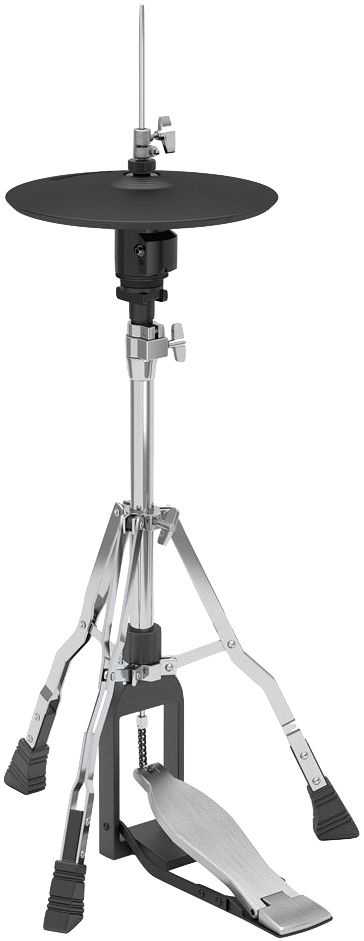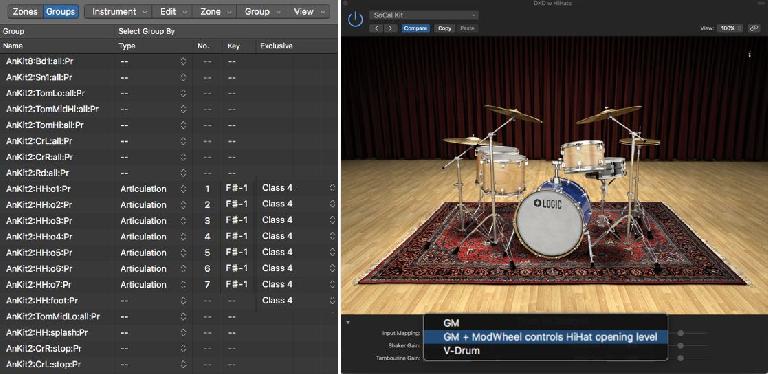Today’s electronic drum kits are a far cry from early models—stiff, noisy pads have given way to quiet mesh heads with natural response, and clichéd synthetic beeps and boops have evolved into sophisticated, highly realistic drum and cymbal sounds. But even with the high-quality sounds of today’s kits, electronic drummers still may choose to use those kits to trigger their favorite virtual drum plug-ins. Often this can be relatively straightforward to set up, but there are still a number of issues that may frequently crop up between hardware and software.
Mapping
Obviously, the main concern when using an electronic drum kit to trigger Virtual Instrument drum sounds is mapping the trigger notes generated by hitting the pads and cymbals of the kit to the correct notes for the matching drums and cymbals in the VI. If both utilize the official General MIDI drum-note standard, then you’ll be good to go, but the General MIDI drum standard is almost universally considered way too simplistic and too limiting for truly expressive drum instruments, so both e-drum kits and the better drum VIs tend to use their own custom drum maps, to allow for greater nuance and musical expression.
When re-mapping is needed, it can be set up in either the source or the destination. Some e-drum kits let the user select which notes are output from the various kitpieces; with others those notes may be fixed, but either way a chart in the documentation usually lists the notes to facilitate mapping.
If the mapping is to be done in the DAW, again, there are two ways to approach it. Many drum VIs include the option to re-map the factory default note assignments within the plug-in, usually with the option to save a custom map for use with a particular e-drum kit. If the kit in use is a current, popular model—like Roland’s V-Drum kits, for example—some drum Instruments may already have a preset map for that kit already set up and available; the most full-featured drum VIs are likely to include such maps for many of the most widely-used e-drum kits.
Even if the preferred drum VI doesn’t include a built-in re-mapping feature, many DAWs have MIDI plug-ins or processing options that can handle the job. Note-by-note pitch transposers or Transform features can usually handle the necessary note re-assignments—for example, Logic includes not only a realtime MIDI Transformer/mapper, but also a MIDI plug-in that can be adapted from its designated Chord Trigger application to be used as an individual note-by-note drum re-mapper.
Multiple Samples And Expression
But sometimes drum note re-mapping is not always as straightforward as simply re-assigning one note for each drum or cymbal. Both high-end drum plug-ins and the drum brains in many e-drum kits often utilize more complex triggering assignments than one-note-per-drum. For example, it’s common for e-drum kits to trigger different snare sounds for the same drum—a standard center hit for strokes in the center of the drum head; a hard rimshot sample for rim hits; and even a ballad-style sidestick sound when the rim is struck softly.
In some less sophisticated (read: cheaper) e-drum kits the snare and rim samples may both be triggered from center hits at different MIDI Velocities. Depending on how the drum VI handles this, it may have to be accounted for via MIDI programming in the DAW or the VI. And not only might there be different samples triggered at different MIDI Velocities, but sometimes in response to where the drum is hit as well—for example, a thinner sample for strokes near the edge of the drum head—incorporating positional sensitivity. This is also frequently employed for e-cymbals, with the position the cymbal is hit triggering regular ride, bell ride, or crash samples.
If this kind of variation is implemented in both the e-drum kit and the destination drum VI as different notes for each of the different sounds, then it may require a little more effort to re-map those notes to the appropriate samples in the plug-in kit, but it should still be relatively easy to do. But sometimes the e-drum kit may incorporate MIDI control data to differentiate between multiple samples for the same drum or cymbal. This can present more of a problem, if the virtual drum kit doesn’t respond to those MIDI messages. The re-mapping may still be do-able without sacrificing too much of the e-drum kit’s expressive response, but that might require more complex MIDI mappings, like note assignments that are determined by the current values of certain controller data.
A good example is an e-drum kit’s crash cymbal choke feature—grabbing the cymbal may generate a choke note or, again, controller data; if it’s the latter, then that CC data might need to be converted to a MIDI note, if that’s how the target drum VI implements cymbal chokes. DAWs with more sophisticated MIDI capabilities can usually handle this with a little extra MIDI programming work, but not every DAW or drum VI may be able to fully translate the nuances of the drummer’s performance in every case.
HiHat
The kitpiece that most often bumps up against this kind of issue is the hihat.

E-drum hihats often utilize CC data for openclosed functionality
Generally, there are two ways for a drum VI to implement the variety of partially-open hihat sounds between fully-closed and fully-open hihats: have several samples that are discretely triggered from different notes; or have all the hihat samples triggered from the same note, selected or cross-faded via controller data.
The latter approach is quite common in both e-drum kits and virtual drum Instruments. The official, designated MIDI Controller for this is CC#4, formally designated Foot Control in the MIDI spec, and some e-drum kits (V-Drums) do use this CC for that purpose. However, CC#1 is also often utilized, no doubt due to its being more widely available from keyboard modwheels, for finger-drummers. Converting between the two should be relatively straightforward, and is often an option in kits and instruments that use the CC approach for hihat openclose control.
The bigger problem may come when one uses the one-hihat-note plus CC method, and the other lays out the different closed/open samples on separate keys. In the worst case scenario, hihat parts played on a CC-based e-drum kit will end up all sounding like closed hihats, triggering only one of the VI’s various note-based hihat samples, ignoring the CC pedal data that “opens and closes” the hihats, losing a critical aspect of the musical performance. Some drum VIs may incorporate options for both approaches: for example, Logic’s Drum Kit Designer offers the choice of simple note-based GM-compatible open/closed hihats, or its preferred mode of operation—which is intended for use with a V-Drum kit—which maps 7 levels of openclosed samples on the same key to CC#4.
Since e-drum kits—at least the better, higher-end models—are more likely to use continuous CC data to control the hats, a drum VI that doesn’t directly support this would require MIDI processing that converts the one hihat note from the kit to the different notes it uses for the various hihat samples, based on the current value of the incoming CC data from the kit’s hihat pedal. Again, DAWs with more sophisticated MIDI processing features should be able to handle this with a little expert programming, but this may be beyond the capabilities of the average user; fortunately, suitable patches can often be found via the DAW’s or the e-drum kit’s various user forums—the topic frequently shows up in these forums.
Wrap Up
Despite the issues of multiple note assignments, mismatched CC data applications, and complex hihat control issues, with a little luck and, if necessary, a little due diligence in problem-solving, it shouldn’t be too hard for modern drummers to set up their favorite e-drum kit as a controller for their favorite VI drum plug-ins. With suitable sound sets and a nice, playable kit, this can go a long way to generating more expressive, musical drum parts.





 © 2024 Ask.Audio
A NonLinear Educating Company
© 2024 Ask.Audio
A NonLinear Educating Company
Discussion
Want to join the discussion?
Create an account or login to get started!